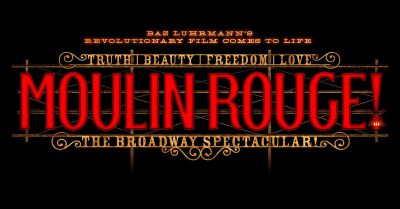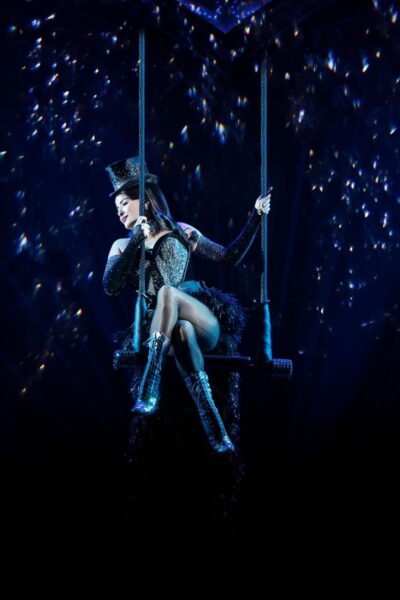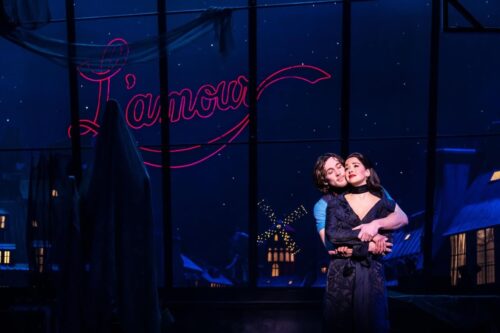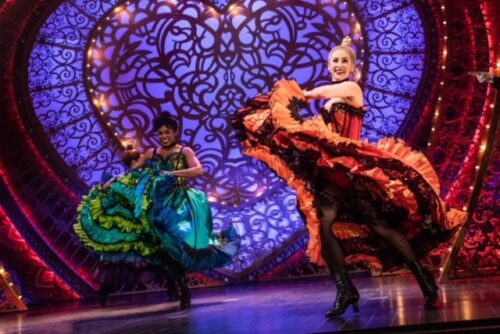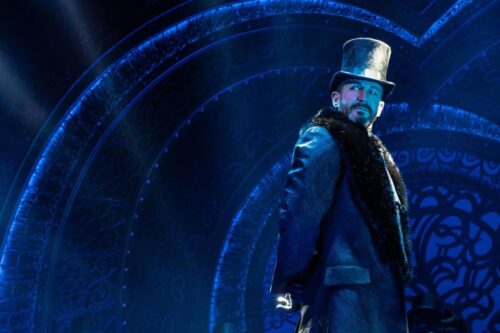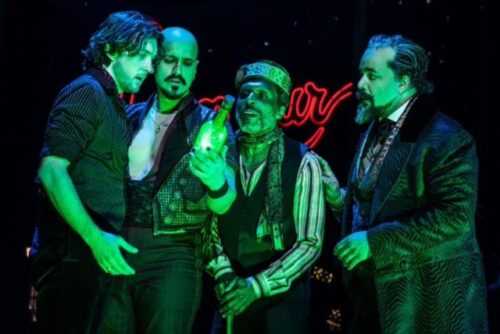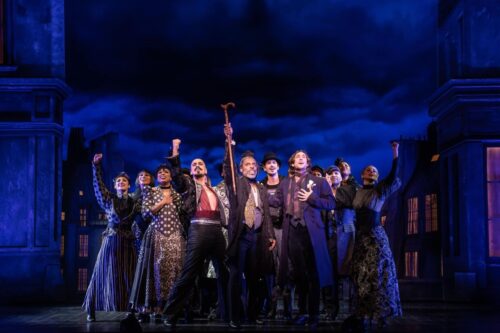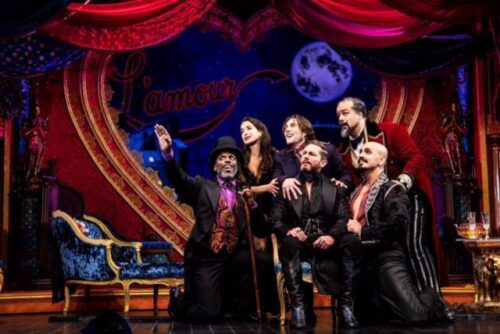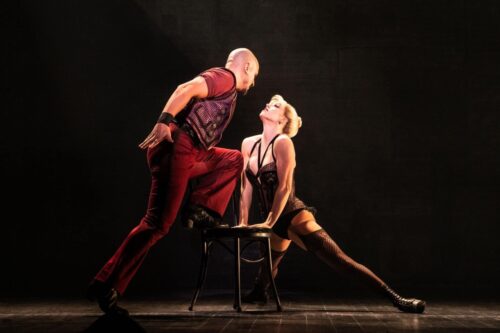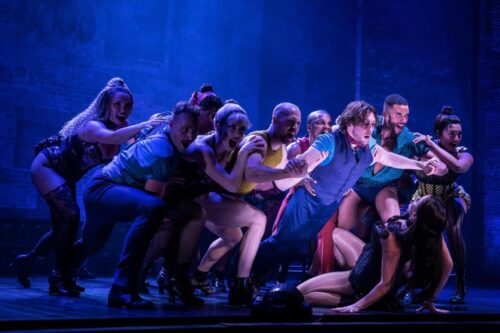MOULIN “ROGUE”!
It wasn’t just the powerhouse romance between Ewan McGregor and Nicole Kidman. With its frenetic theatrics and killer soundtrack (virgin ballads locking lips with re-imagined pop hits), Baz Luhrmann’s epic, high-octane love story, Moulin Rouge! (2001), was always destined for the stage. But Broadway, it appears, is the Duke in disguise here, promising the property a rich and lavish life ’¦ in exchange for its soul. In the award-winning Moulin Rouge! The Musical, now playing at the Hollywood Pantages Theatre, exaltations of Truth, Beauty, Freedom, and Love remain intact. As does luxurious excess. But it’s as if the new creators are so certain they could never recreate the emotional tightrope act that Luhrmann achieved with his Bohemian opus that ’¦ they don’t even appear to try. Directed by Alex Timbers, with a brand new book by John Logan, Moulin Rouge!’”once a “goof-bollywood” hybrid of quirk and high drama’”offers just enough glam, glitz, and (updated) pop hits to make you forget: long ago, it once beautifully broke your heart.
The setting’s the same: 1899 Paris, the Belle Époque period of artistry. In a decadent cabaret known as the Moulin Rouge, the rich and powerful co-mingle with denizens of the underworld. The club appears to be *the* place to dance your troubles away’”except’”in this adaptation at least, it’s on the brink of ruin. Without a rich financier to save the day, its workers are bound for the streets. This new, and completely unnecessary, storyline is a surprising one, as it makes the fate of the club integral to the plot. Even more surprising is that it goes completely unresolved by the end because ’¦ who cares, let’s dance!
You may have noticed that I’ve yet to say anything about the love affair between a penniless writer named Christian (Conor Ryan) and a beautiful courtesan named Satine (Courtney Reed). That’s because, here, it takes a while to even get into that storyline, much less showcase its significance. This, obviously, is a marked change from the beginning of the film where, surrounded by empty bottles of booze, a grieving Christian, underscored by a melancholic “Nature Boy,” announces over his tear-stained typewriter that the woman he loved ’¦ is ’¦ dead. In the stage version, we open with “Lady Marmalade,” followed by other “gitchie-gitchie-ya-yas” like David Bowie’s “Let’s Dance.” The concept here is clear: this is a jukebox musical. Put bluntly: song over story; fun over feelings. If the audience cries, it’s not from the release of their hearts ’¦ but from flying confetti getting lodged in their eyes.
Here, Christian is no longer a smooth, British-accented charmer, but an “All-Amurrr’can” from Lima, Ohio. (Yes, seriously.) Conor Ryan is certainly handsome and endearing as Christian, and his gorgeous rendition of Elton John’s “Your Song” made me melt. But what were they thinking in making him so plainsville? That audiences wouldn’t relate to him being English, even though ’¦ we already did? Unnecessary changes like this are found all over the work. Meanwhile, Courtney Reed, with her stellar pipes and flowing dark hair (in contrast to Kidman’s signature red locks) is a dazzler as the “Sparkling Diamond,” Satine. It’s a shame, then, that her and Christian’s love story wasn’t taken more seriously and actually made the centerpiece of the show, rather than a side one’”both to the musical catalog and the silly “fate of the club” storyline.
Speaking of side pieces, the musical makes Christian completely okay (at least initially) with being Satine’s #2. Instead of watching the couple’s angst grow in proportion to their deepening love as they try to deal with Satine being pressured to sleep with the evil Duke of Monroth (David Harris), here she sleeps with the Duke right away to “save the club.” Worse, an emasculated Christian actually tries to convince himself (and the audience) that having a secret affair with a woman locked-in with another man (and controlling brute, at that) is somehow ’¦ hotter. I’m sorry, but what? The tension created in the film is totally lost here. I don’t know if this is some political statement about the legitimacy of sex work that men need to support at all costs (I wouldn’t be surprised), but it’s cheapening the love story. I was waiting for Christian to break out into Enrique Iglesias’s 2001 love-ballad “Hero” singing: “I could be your side-ho, baby!”
Another awkward moment is when Christian, at the top of Act II, breaks the fourth wall and asks the audience to think back to the first time they, too, fell in love. Just picture it, he says, and feel those feelings of giddiness and excitement. As the show goes on, remember your feelings in order to understand what’s happening between him and Satine, and all the crazy things that are about to happen. If that’s not ridiculous enough, as a cheap ploy for drama, they almost try to turn Christian, not the Duke, into the story’s biggest psychopath. Another big character change is having the Duke no longer being presented as a smarmy, mustachioed sleaze, but a swaggering devil in black leather.
The new musical renditions are hit-or-miss. While many in the Moulin Rouge! Playbill are credited with musical contributions, it’s music supervisor and co-orchestrator Justin Levine who’s responsible for arrangements and additional lyrics. The work is known for its anachronistic pop hits rearranged and contextualized to comedic or sweeping effect. Since the movie came out in 2001, there’ve been a lot of great songs added to the music canon. Here, over 55 pop hits are found in the show, from older ones featured in the original film, to new ones from artists like Beyoncé, Fun, Sia, The Rolling Stones, Katy Perry, and Adele. Granted, by 2022 standards, even the newest songs are dated (the most recent being from 2014). On Opening Night, reactions to the selections were mostly mixed-to-positive. Some garnered instant applause, while others evoked laughter, whether intentionally or not.
Not all the updates work or elevate the piece. Sometimes people just want to hear the songs as they know them. My guess is that those requesting “Elephant Love Medley” at karaoke bars in the future are going to opt for the original film version, not the mixed-bag of a remix heard here. That said, however, the showstopper at the top of the second act featuring two pop princesses (or queens ’¦ I’ll leave you to duke out their labels) resulted in extended applause, with a quarter of the audience giving it a standing ovation. This moment is also one of the major dance numbers in the show, allowing Sonya Tayeh’s sleek choreography to shine.
My guess is that a lot of the excitement regarding the more successful musical moments is from a combination of the “surprise factor”: which new songs will they pick? where will they show up? and how will they be arranged? and ’¦ the joy of hearing great, recognizable songs from artists we love. Familiarity is a sure bet for Broadway. When people are won over before they even enter the theater, the show doesn’t have to earn their love’”it just has to not lose it.
Derek McLane’s over-the-top set, lit gorgeously (especially in bright, neon red) by Justin Townsend, is “spectacular, spectacular.” As I write this, a giant windmill and elephant adorn the red-curtained stage of the Hollywood Pantages Theatre. Catherine Zuber’s costumes are also quite exquisite. Because so much of the show takes place in a nightclub where people come dressed to the nines in styles seemingly modern, it’s not until later that we venture out into Paris and see what the commoners look like. Here, they are appropriately “period,” with ladies holding elegant parasols. In a nod to the eccentric nature of the work, many are also sporting bright pink wigs (David Brian Brown, hair design). In most other contexts, such a look might appear eccentric; in Moulin Rouge!, it’s par for the course.
In the early 2000s, Baz Luhrmann was that “pink wig eccentric,” giving us something we hadn’t seen before. This musical, disappointingly, wants to cram it into the modern Broadway “formula.” Revamping the tale with myriad alterations, backstories, and surprises to justify a new incarnation, it strays away from the richness of its source material in search of something easier to pull off. For my tastes, it plays it far too safe and commercial, shying away from the story’s heart’”and heartbreak. It leans into a musical catalog that’s certainly fresh and occasionally shines, but I’m not convinced it works as well as the original.
If you’re looking for the tone and emotional depth of Luhrmann’s ingeniously crafted love story, simply ’¦ re-watch it. Or see the show based on the same Greek myth (Orpheus and Eurydice) that Luhrmann claims as inspiration for Moulin Rouge!: Hadestown. That, ironically, is more Moulin Rouge! than Moulin Rouge! The Musical. That all said, if you go, you’re still likely to have a good time. Despite all of my reservations, I still had fun. It’s better to see it as its own thing ’¦ then watch the movie afterwards. If you go, raise a glass (of absinthe, if you have it) to Moulin Rouge!’s 21st birthday. By the time you reach that “downer” of an ending, you’ll be ushered into a happy, clappy, toe-tappy sing-along, spirited by the Green Fairy. It’s all about the fun, remember?
P.S. Satine, it’s 1899 ’¦ put on your mask!
photos by Matthew Murphy
Moulin Rouge! The Musical
North American Tour
reviewed at Hollywood Pantages (Broadway in Hollywood) — ends in L.A. June 9, 2022
also plays in Costa Mesa at Segerstrom Center November 9-27, 2022
most perf: Tu, Thurs, Fri at 7:30; Wed at 2 & 7:30; Sat at 2 & 8; Sun at 2 & 7:30
for more tour dates and cities, visit MoulinRougeMusical.com
